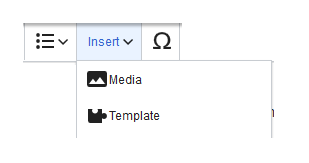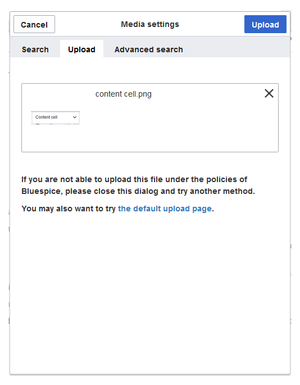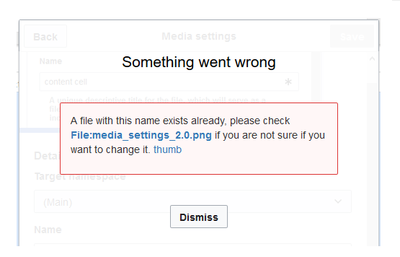VisualEditor: Insert Images
-
- Last edited 5 years ago by MLR
-
Contents
How to insert an image on a page
In addition to text, images are probably the most important components of typical content pages. With VisualEditor, the images can be uploaded, inserted and formatted all in one step Here we highlight the most important questions when inserting images with VisualEditor. Pictures are inserted via the menu item Insert > Media:
The dialog box Media Settings opens.
When you upload a new image, the following note greets you:
"If you are not able to upload this file under the policies of (your wiki), please close this dialog and try another method. You may also want to try the default upload page."
You can ignore this notice if your wiki administrator did not create copyright policies. If in doubt, contact your administrator regarding the image usage rights in your organization.
After uploading, you can edit the image settings: Details, General Settings, and Advanced Settings.
Details
Here you can assign a namespace and categories to a picture.
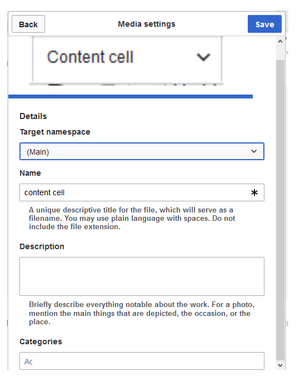
- Target namespace: The picture can be assigned directly to a namespace. The access rights of the namespace are also applied to the image. This means that only users with access to the namespace can view the image on the wiki.
- Name: Choose a name that makes it easy to find the image later during an image search. Or simply leave the current file name.
- Description: The description is mainly useful for photos or infographics when the image name does not adequately describe the image content.
- Categories: Here, the picture can be assigned to categories.
Error message when saving: If the image already exists, an error message is displayed. If you want to overwrite the existing file, you can click on the file name and overwrite the file via the image page in the wiki. This is done by clicking the "Upload a new version of this file" link in the "File Versions" section. In VisualEditor itself overwriting an image does not not work:
General Settings
Here, the image descriptions are added:.
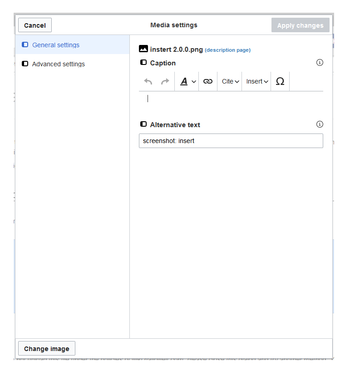
Caption: The caption is used in framed images and thumbnails. Note: If you change an image to frameless and then back to "framed", you need to re-enter the caption.
Alternate text: The alternate text should be entered for each image since it replaces the image in certain contexts. For example, this so-called "alt" text is used by users who work with screen readers. Screen readers are used by users with visual limitations, but search engines can also read this text. In some business areas, the indication of the "alt" text is also required by law. If you are not sure, ask your company accordingly.
Advanced Settings
In the advanced settings, you can set the position and image size. 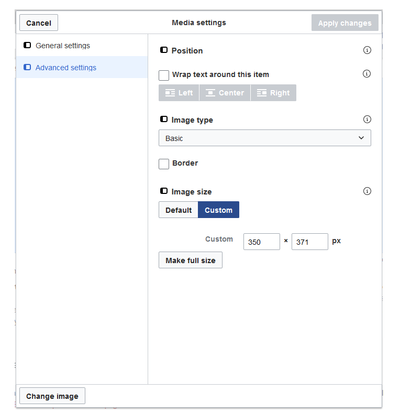
The following settings are possible:
- Position:
- Wrap text around this item:
- Left: The image is displayed on the left side of the text, starting on the first line of the current paragraph.
- Center: The image is displayed centered over the current paragraph.
- Right: The image is displayed to the right of the text, starting on the first line of the current paragraph.
- Wrap text around this item:
- Image type: If you insert an image with VisualEditor, the image is usually linked to the Media Viewer. To suppress the link on an image, you must add an empty link attribute to the image tag in the source code:
- frameless picture with link (standard):
[[File:adult-chair-company-380769.jpg|frameless]] - frameless picture without link:
[[File:adult-chair-company-380769.jpg|frameless|link=]]
- frameless picture with link (standard):
- Iamge size:
- Standard: sets the image width to 300px.
- Custom: allows setting a custom size.
- Make full size: resets the size to the actual image size.
Where do I save the image
You can easily save pictures and files in the general namespace (pages). If you have created additional namespaces, you can also save images in these namespaces if you have the necessary access rights. If pictures should be accessible by all users, you can save these pictures in the main namespace.
How big is my picture?
How big should the image be so I can use it on a wiki page? The question depends on what you need to do with the picture. Often, a picture will be displayed as a thumbnail small on the page first. The picture itself can then be viewed in its original size.
If you want to create PDF manuals, the images should be uploaded as large as possible. However, it is important to remember that the files will not get too large for your wiki pages to load quickly. Images over 100 KB are rather unusual on a web page, while images under 20 KB are often not sharp enough when printing on paper. If you create documentation with your wiki, which is also printed out as a manual, then you should consider a suitable strategy.
How do I change an already uploaded image?
In the editing mode of the page, it is possible to edit the image with a double-click. Use the "Change image" button to exchange the image accordingly.
If you want to use a new version of the same image, open the "Special:Upload file" page in a new browser tab (so you do not lose any changes on your wiki page). There you can save already existing pictures with or without warning under the same name again. The original image is kept as a version.
